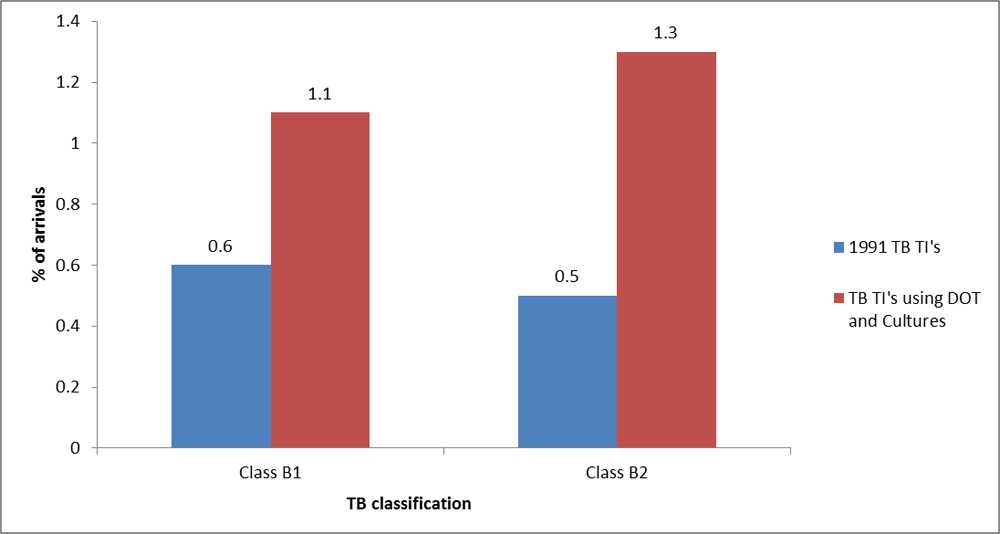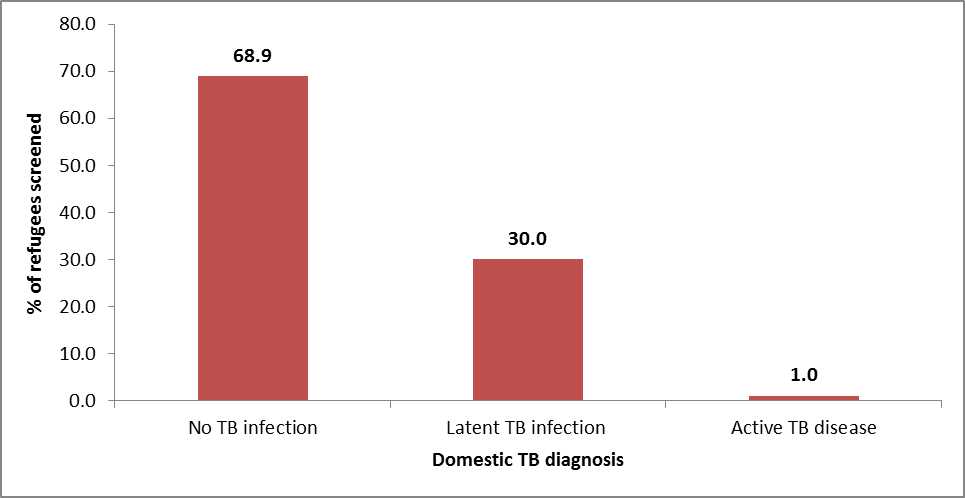Communicable Disease: Tuberculosis
Congolese Refugee Health Profile
Among Congolese refugees screened under the 1991 TB Technical Instructions from 2008–2013, approximately 0.6% (n=31) arrived to the United States with a Class B1 TB designation (defined as TB fully treated using directly observed therapy, or abnormal chest x-ray [CXR] with negative sputum smears and cultures, or extrapulmonary TB) (Figure 10). Of those screened under the 2007 TB Technical Instructions from 2008–2013, 1.1% (n=56) arrived in the United States with a Class B1 designation. During the overseas medical examinations, tuberculin skin tests (TST) are routinely performed on children aged 2–14 years (whereas all adults receive chest x-rays). Children who have a positive TST and normal chest x-ray findings are designated as TB Class B2 LTBI (latent tuberculosis infection). From 2008–2012, approximately 1.3% (n=66) of children examined by IOM physicians using the 2007 TB Technical Instructions in Burundi, Rwanda, Tanzania, and Uganda had a positive TST with >10 mm induration (Figure 10). During post-arrival screening exams in 4 large Congolese refugee-receiving states, approximately 30% (n=145) of those screened had latent TB infection, while only 1% (n=5) of those screened had active TB disease (Figure 11).
Of more than 4,938 refugees screened for active TB during visa medical examinations conducted by IOM physicians in Burundi, Rwanda, Tanzania, and Uganda, only 1 (0.02%) was sputum smear or culture positive for Mycobacterium tuberculosis and completed treatment overseas. Only 26 (0.5%) Congolese adult refugees were classified with Class B2 TB using the 1991 TB technical instructions.
Figure 10: Overseas TB classifications using the 1991 TB Technical Instructions and the 2007 TB Technical Instructions using directly observed therapy (DOT) and cultures for Congolese refugees who resettled in the United States from 2008–2013 (n=4,938)

1 TB Class B1 using the 1991 TB technical instructions is defined as having an abnormal chest radiograph suggestive of active tuberculosis and a negative acid-fast bacilli sputum smear.
2 TB Class B2 using the 1991 TB technical instructions is defined as having an abnormal chest radiograph suggestive of inactive tuberculosis. Source: EDN
3 TB Class B1 using the 2007 TB technical instructions is defined as having a medical history, physical exam, or chest radiographic findings suggestive of pulmonary TB with negative acid-fast bacilli sputum smears and cultures or having had a diagnosis of pulmonary TB but successfully completing directly observed therapy prior to immigration to the US.
4 TB Class B2 using the 2007 TB technical instructions is defined as having a tuberculin skin test >= 10mm induration or a positive IGRA and a negative evaluation for TB. Source: EDN
Figure 11: Domestic TB diagnoses of Congolese refugees who were screened for TB in 4 states from 2008–2013 (n=483)

Source: Refugee health screening data from health departments in California, Colorado, Illinois, and New York
- Page last reviewed: August 29, 2014
- Page last updated: August 29, 2014
- Content source:


 ShareCompartir
ShareCompartir